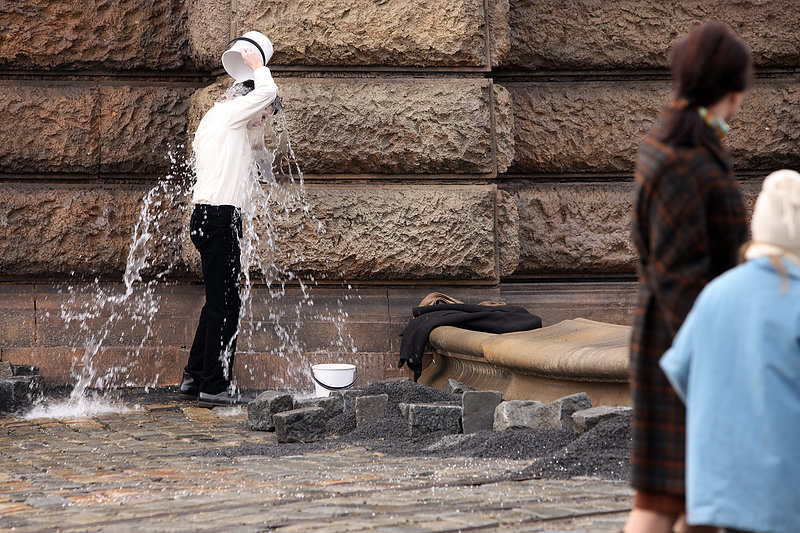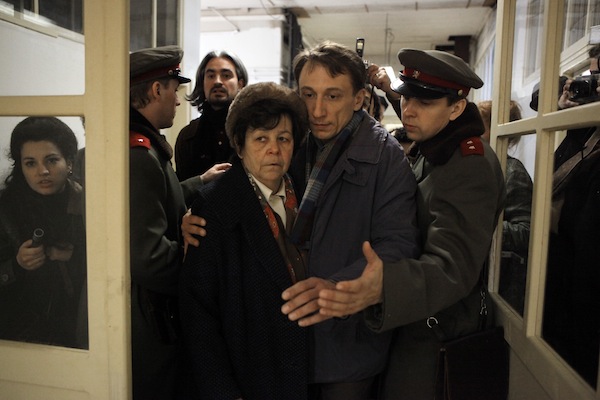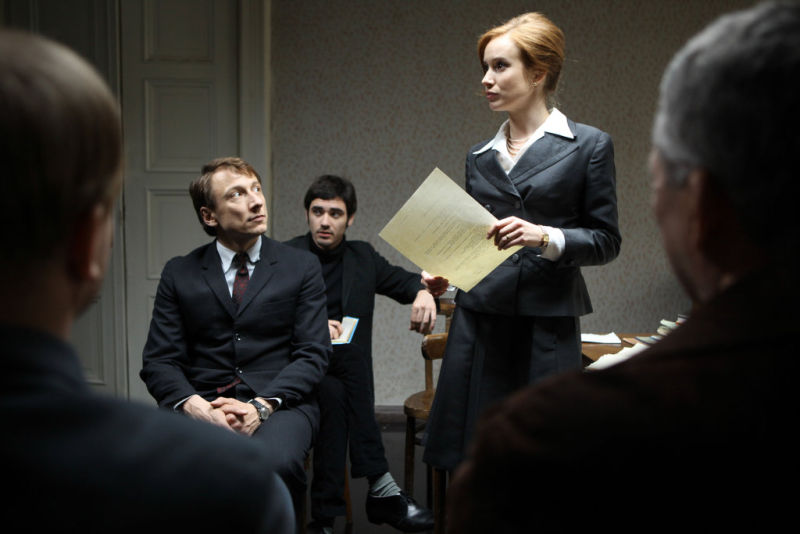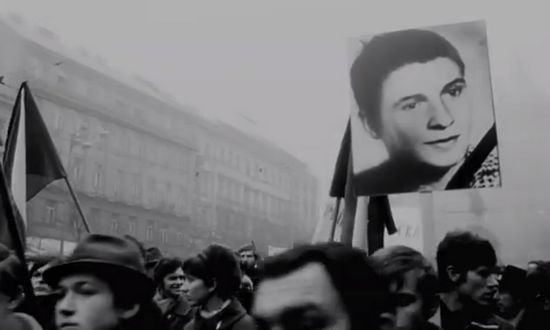Agnieszka Holland’s brilliant, ambitious, and moving new film, Burning Bush, begins at a violent and traumatic moment in Czech history. In the opening scene, a young student stops next to a fountain outside the museum in Prague’s Wenceslas Square, douses himself with gasoline, sets himself on fire, and runs, screaming, into the street, where he collapses. It is January 16, 1969, five months after Soviet tanks had brought an end to the so-called Prague Spring, and the student, a young Czech named Jan Palach, has left a letter making it clear that he is acting on behalf of a larger, unidentified opposition group to protest against government censorship and the Soviet occupation. The letter demands that the censorship of the Czech press be lifted and that Zprávny, a propaganda newspaper for the occupying armies, be abolished; it also calls for a general strike. If these demands are not met within five days, the letter states, more self-immolations will follow. The letter is signed, Torch Number One.
At the time, there was profound resentment of the occupation forces, and also fear—on the part of the Czech establishment—that a new wave of protest might provoke to the Russians to take even harsher and more repressive measures. Holland and her screenwriter, Štěphán HulÍk, have compressed and simplified certain events (the details of a court case, for example) for clarity and concision, but what happens in these early scenes and in much of the film is a matter of historical record. We watch as Palach, severely burned, is loaded into an ambulance and brought to the hospital, where he lingers for a few days. His brother is contacted and travels to a small town outside the capital, to tell their elderly mother about Jan’s injuries. As it happens, Mrs. Palachová (Jaroslava Pokorná) is at that moment on a train to the city, where she plans to buy a new coat for Jan. She finds out what has happened to her son when she glances at a newspaper that another passenger is reading.
It must be a challenge to dramatize, on screen, the fact that a single event can have enormous political repercussions—that is, to do it without resembling one of those dreary biopics or socially relevant dramas in which exposition and explanation masquerade as dialogue. (One thinks of Ed Asner as the police chief in the 1981 Fort Apache, The Bronx, standing at the window of his precinct office and helpfully reeling off the income statistics of the neighborhood below.) Holland and HulÍk skillfully make us understand how many people, at how many different levels, had a stake in trying to hush up Palach’s death or, conversely, to turn it into a call to arms.
The film’s plot takes up several strands of narrative that will ultimately be woven together. One concerns the detectives and the police who fear that there will be other “torches”; they are desperate to locate Palach’s co-conspirators before more deaths occur. The stresses on them, and their fears, are complex; a rash of suicides would not only create a new group of martyrs who would be potent symbols of resistance, but might persuade the Russians that the Czech puppet government is incapable of keeping its own house in order. Meanwhile, the veterans of the student protest movement hope that Jan’s letter—which is published in a student newspaper despite the reservations of the authorities—might inspire railway workers and other unions to join with the students and strike. And when Jan dies a few days after his burning, thousands of people take part in a mourning procession through the streets of Prague.
A further element of the plot—one that becomes increasingly central as the film progresses—is set in motion when a lawyer, Dagmar Burešová (Tatiana Pauhofová), agrees to represent Mrs. Palachová in her case against Vilém Nový (Martin Huba), a Communist Party official and member of parliament, who has made extravagant allegations against her son. Nový is quoted in the newspapers as having said at a meeting of MPs in a town outside the capital that Jan Palach was a stupid, unstable dupe of Western spies and right-wing extremists, who had convinced him that the fire would be an illusion, a kind of magic trick, and he wouldn’t get hurt. After first refusing, Burešová decides to take on the case against the sensible advice of her husband, a doctor in a Prague hospital, and in full knowledge that her decision will almost certainly have serious consequences for herself and her family.
Advertisement
Yet another subplot concerns Dagmar’s boss, Vladimir Charouz, a lawyer whose daughter is active in the student protest movement; knowing that she will be in danger when the inevitable investigation (and persecution) of the students begins, Charouz, like nearly every character in the film, must choose between his personal loyalties and the bravery required to act with honesty and conviction. We are reminded of the cynicism and the ruthlessness with which a totalitarian government will use anything and everything—a child, a loved one, a career, a livelihood—to bully its people into silence and submission.
There are at least a dozen stellar actors in the film, but perhaps the most spectacular is Jaroslava Pokorná as Mrs. Palachová, whose shock and sorrow transform her into a mythic figure: part doughy-faced babushka, part Mater Dolorosa. Every artistic choice Pokorná makes, every emotion conveyed in the stance of her thick-set body and fleeting across her mobile, expressive features reminds us there was a real Mrs. Palachová, who—like her onscreen counterpart—was so determined to defend her beloved son against the lies that were told about him after his death that she took the extraordinary step of suing, in court, a member of Parliament and a prominent Communist Party member. The fact that she was not a political radical but rather an ordinary Czech citizen whose son had been wronged made her action all the more powerful—and more threatening to the authorities. Another striking performance is that of Martin Huba as Nový, the politician and defendant in Mrs. Palachová’s case, whom he portrays as a fatuous liar and a coward who wants to dispense with his conscience and still be able to think of himself as a decent human being.
Divided into two sections, Burning Bush lasts for four hours. Yet the detective’s frantic efforts to learn if there are other would-be human torches, the fierce, almost reckless courage shown by Dagmar and her associates as they launch their inquiry into the truth about Nový, the cruel harassment of Mrs. Palachová by officials determined to intimidate her into dropping her suit, and the moral dilemmas faced by the other characters generate so much suspense that we hardly notice (or mind) how long the film is. Part of what makes the film so affecting—and what makes it length seem so necessary—is the pace and patience with which it documents the gradual change undergone by its protagonists, and by the society in which they live; Burešová and her associates begin by imagining, or hoping, that they may get justice for the Palachs; and they (like the audience, who watch the behind-the scenes manipulation of the judge and the legal process) eventually come to realize how heavily the deck is stacked against them, and how unlikely it is that anything of significance will change.
The set designers and art directors have meticulously recreated the appearance and the atmosphere of that place and time; the grime, the grayness, the utter lack of color and comfort, the chilly miasma of powerlessness and hopelessness that seems to emanate from the dilapidated buildings and their neglected and battered interiors. The difficulty (and expense) of erasing a half-century of modernization and restoring the urban settings to the way they looked during the 1960s was accomplished partly through an ingenious use of special effects, employed in post-production. Watching the film, one can almost smell the very particular scent of Eastern Europe before and just after the fall of Communism: an unmistakable combination of dust, mildew, cooked cabbage, and the stuffiness of closed rooms whose inhabitants fear catching a fatal chill if they open a window. The locations, the costumes, the furniture, the medical and office equipment all contribute to the impression of authenticity.
Segments of archival footage are interspersed throughout, but early on, we understand that Holland is affecting our emotions in ways that would likely exceed the reach of even the most skillful documentary filmmaker; these are the aspects of the film that transform it from an artful historical drama into a work of art. This is largely a result of the inspired script and of the virtuosic performances that Holland has coaxed out of her cast. The way in which history shapes (and destroys) individual lives is conveyed by a succession of brief, often intimate scenes that might seem extraneous to the central drama but are essential in making us understand who these people are—and what happens to them.
After Dagmar Burešová’s decision to sue Vilém Nový for defamation of character has led to her husband being wrongly accused of professional misconduct and forced out of his hospital, we watch her waking up at dawn to make him breakfast before he must leave to commute to work as a general practitioner in a town outside Prague; we understand, without having to be told, the guilt she feels for having unwittingly but predictably wrecked her husband’s career. Late in the film, there is a stunning scene in which we realize that Jan Palach has become so famous, or notorious, that his mother is recognized by her fellow passengers on a tram; watching her response to this unwanted fame, after the suffering she has endured, is to see an astonishing actress turn a few moments on screen into something excruciating—and unforgettable.
Advertisement
At the end of the film, we are reminded that, twenty years after his death, Jan Palach again became a powerful symbol when the Czechs rose up against the Communist government in 1989. Later that year, Burešová would also be vindicated by becoming Minister of Justice of the first post-Communist administration. But everything we have watched over the previous four hours makes us painfully aware that this symbolic resurrection would have been of only limited consolation to those whose human tragedy, whose loss and grief, we have witnessed.
Agniezska Holland’s Burning Bush is showing in two parts at New York’s Film Forum through June 24. For the full text of Jan Palach’s letter together with a contemporaneous account of Prague, see Jiri Mucha, “Prague After Palach,” The New York Review, February 27, 1969.






